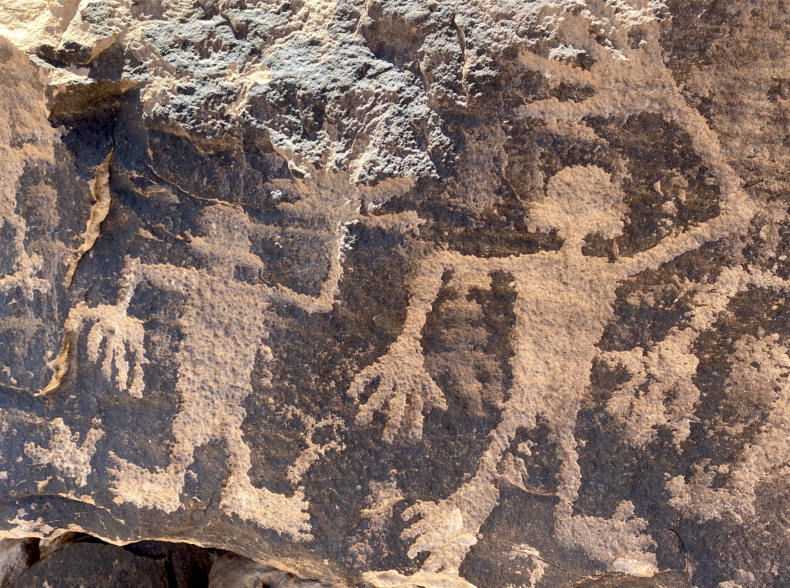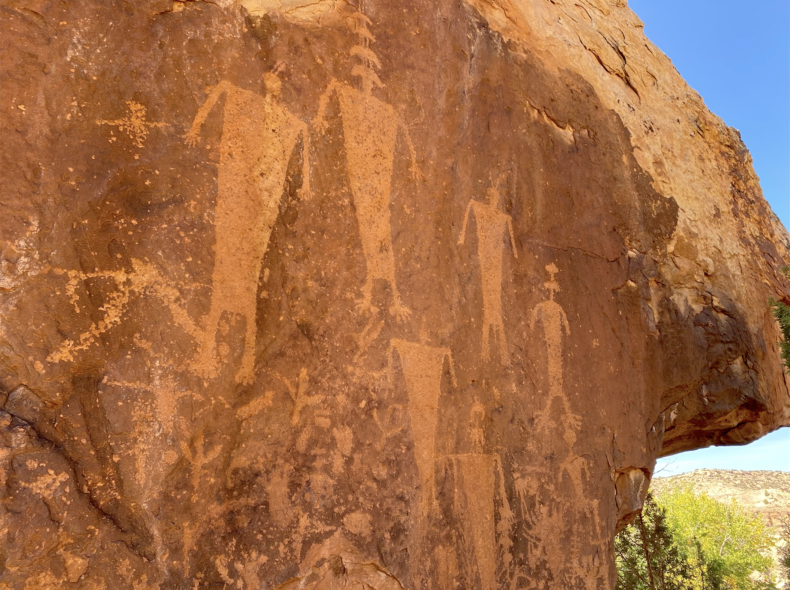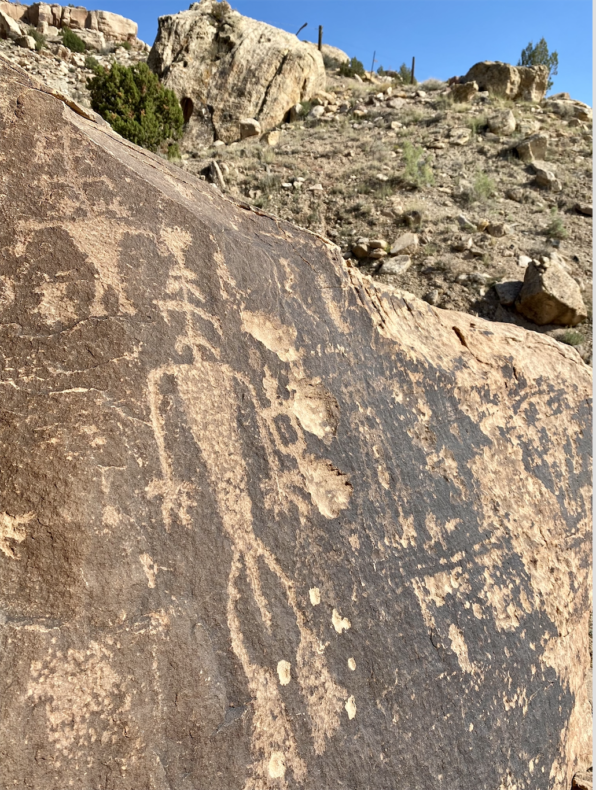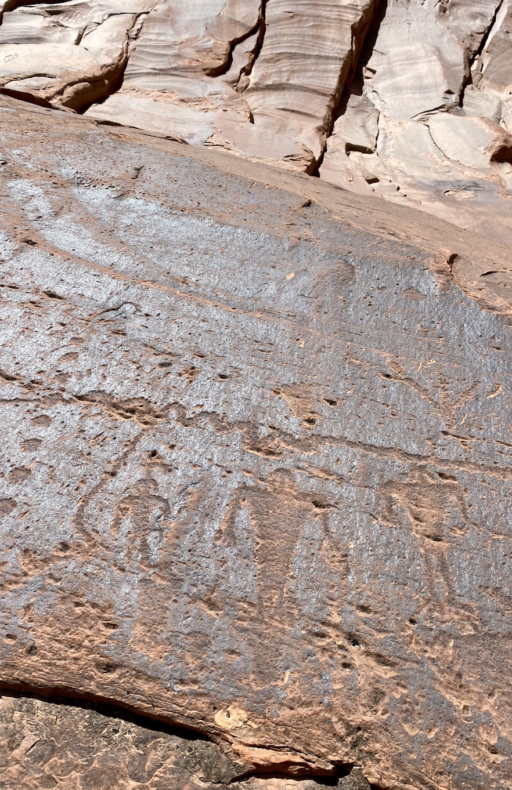
My in-laws are visiting from the East Coast and we’ve had some days to explore. The local bar in our five-hundred-person town is a must-see, its sleek wood and mirrors more than a century old, and the old mountain-mining town of Telluride is forty-five minutes away for window shopping and looking for famous people. The bulk of our days, however, we’ve spent with much older points of interest. If you’re coming all the way from the other side of the continent, I wouldn’t want to be frivolous.
My wife planned most of the tour, a whirlwind of sun-filled valleys and cliffs. The desert of southwest Colorado in October is at its peak, green from summer rains, warm but not searing. We mince our way up canyons, over boulders the size of bedrooms, and follow dry washes and backroads, our truck loaded to take us to the next stop and the next.
A man unlocks a gate near a permanently closed trading post and lets us through. A mile or so down the road, we park under cottonwood shade. Near the outbuildings of a desert ranch, the in-laws spot a boulder across the road pecked with a fifteen-hundred-year old anthropomorph. They’re getting good at spotting images, recognizing the style, Basketmaker Culture.
The boulder is the size of a cottage and it has rock art on every side, bighorn sheep, lightning-like snakes, and human figures with plumes and lines coming out of their heads. We have the usual conversation, surmising headdresses or hunts, a dialogue that has to happen at rock art panels.

I came to this family saunter fresh off of a teaching gig for Crow Canyon Archaeological Center in Cortez, CO. This had been a field program in the Utah backcountry, in the contested and soon to be restored lands of Bears Ears National Monument, just over the horizon from where we live. I taught with an Anglo museum curator, a Hopi archaeologist and tribal member, and a scholar from the Ute Mountain Ute Tribe. A dozen participants followed along as we walked to rock art and ruins, which the Hopi archaeologist said were not ruins, not abandoned. They were still on the Hopi map, places very much alive.
The Hopi archaeologist I taught with would say these petroglyphs were spirit people, ancestors, the ones who carried prayers. I’ve also heard them called personifications of clouds, where instead of seeing a rockface of people, you are seeing thunderheads marching toward you, rain bringers.
Who lived here, what identities are still present, and how many thousands of years back do these identities trace? These were the conversations with the in-laws. They talked about where they come from, marshes and shorelines of Chesapeake Bay, and also mentioned the Ice Age and skeletons and ancient tools found along their Choptank River. We compared notes on human presence. I told them this land is Hopi, Zuni, Ute, and Navajo. On top of that is an icing of the Bureau of Land Management with its handsomely weathering signs and two-track roads.

We move from panel to panel, driving fifty miles this way, twenty-five miles that. Most of a day is spent climbing a canyon, helping each other up with hands, searching for routes. We settle under juniper shade at a hunting panel, one petroglyph figure reared back throwing an atlatl as bighorn sheep run. Human footprints and that of a bear have been pecked into the rock using a hammerstone and sharpened bone chisel.
A show of hands, who wants to go farther, and who is ready to start picking their way back down? My teenage son, his older stepsister, and I raise our hands. The in-laws start back, plenty for one afternoon, while the three of us keep going. The canyon rounds into a soaring box, a dead end worn by flash floods until it is as smooth as porcelain. The three of us have been up here before. My stepdaughter grew up in the area, probably saw this canyon from before she can remember. My son and I were here on a Christmas eve years back. It’s a popular spot in our small circle.
In this echoing end of the canyon are petroglyphs of spirals and bighorns and anthropomorphs with all their fingers and toes accounted for. They’ve been pecked into a dark chocolate patina shining as brightly as a mirror. The place feels like a sanctuary, an enormous vault of a cathedral, and these are figures on stained glass, these are saints in their niches. We point them out to each other, studying the images for anything we’d missed before, a vertical row of dots, a human figure with its head missing where sandstone has fallen off. We come as visitors from far away, separated by more than a thousand years and languages we’ve never learned. This is how we pay our respect, stopping in to say hello.

Photos by me.
It astounds me how many thousands of people must’ve walked through all those canyons, living in alcoves and under shelves of stone to protect themselves, or just to flourish day-to-day. And then there are people like you who come upon these secret places and find the stories on the rocks, the news of the day. It all takes my breath away and makes me wish I’d taken a path decades ago to live in that area of the world. Yet, our quantum universes usually wind around each other so that, as far from the Four Corners I drifted, I can still read your stories and touch that forgotten pathway. Thank you, Craig.
Thanks for acknowledging the cloud beings emanating thunder from their heads. Thunder makes the rain spill out. Perhaps by addressing them with reverence and respect their magic indeed brought rain these last few weeks
Thank you for sharing rock art adventures.
Thank you, once again, Craig for sharing your journeys into these once forgotten, although somehow, collectively deeply remembered sacred spaces. As above, as so, within. Namaste, blessings, and, safe travels, always.
Please sign me up for your newsletter! Thank you so much!
Thank you for sharing.